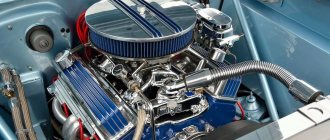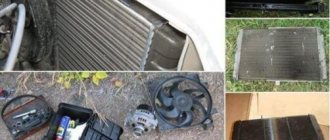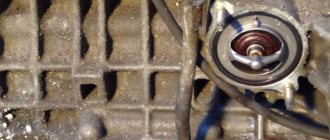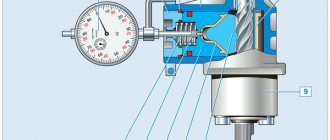Cars admin26.02.2020
Guys, tell me, when driving at first, second speed and in traffic jams, the engine temperature quickly rises to 100, 107 degrees, when driving at high speed the temperature drops to 85 - 90? This is especially noticeable now, in the spring, the weather is warm. Is this normal? phenomenon? What will it be like in the summer at plus 40 degrees? Will I overheat the engine? Thank you all in advance!
Hi all! I recently bought a Lada Priora 1.6 16 cl. 2009 with air conditioning. The car is constantly heating up, the temperature is closer to 100°. I changed the pump and timing belt, at the same time drained the entire system (the plug option is excluded, I think), the thermostat was changed, the pipes are all hot.
Tell me what the reason is.
And another question, maybe someone had! I did a full diagnosis of the injector, the result: not a single error, engine operation is smooth, system pressure is 4, the gasoline filter has been changed. But the car doesn't pull anything? What could this be, what should I do?
Thank you all in advance) I’m already thinking about selling it!
Operating temperature of VAZ 21126 Priora engines
Not only the engine life, but also a number of other performance indicators depend on the operating temperature of the VAZ 21126 gasoline injection 16-valve engine. When the operating temperature is lower or higher than the nominal one, power and dynamics are lost; the temperature affects the operation of the heater and the quality of mixture formation. And this entails indicators on fuel consumption and engine life as a whole. Today we will figure out how to change the operating temperature of the Priora, Tens and Kalina 16 valve engine, what temperature is normal and how the cooling system fan affects engine operation.
Coolant replacement
Note that the technology for replacing the refrigerant in versions of LADA Kalina with an 8-valve engine is somewhat different from the sequence of work on variations of 16-valve engines. In the latter case, to provide access to the block drain plug, you will need to remove the starter fasteners. And before work, we’ll find out how to drain antifreeze correctly.
Procedure for 8-valve Kalinas
- We release the pressure in the previously indicated way.
- We dismantle the crankcase protection.
- We place the prepared container under the drain hole (located on the right side of the radiator).
- You can regulate the pressure of the drained stream of liquid by tightening or removing the plug on the tank. We carry out this manipulation, focusing on the situation.
- Having unscrewed the radiator cap, we wait for the liquid to completely drain.
- Now we move to the motor block.
- The drain plug is located under the ignition coil.
- To unscrew the specified plug, we use a 13-size wrench.
- We substitute the same container and collect the remaining liquid into it.
The antifreeze replacement is complete.
Rated operating temperature of the VAZ 21126 Priora engine
Temperature sensor Lada Priora
This contributes to the normal correct operation of the power system, maximum engine performance, and in addition, the content of harmful substances in the exhaust gases complies with Euro3 standards that were current at that time. And the engine power, as practice shows, remains within the nameplate limits - about 98 forces at 5.5-5.6 thousand rpm. Again, judging by the reviews, and based on practice, fuel consumption during overheating can increase by 15-25%, and when operating the engine at coolant temperatures below 85 degrees, consumption increases by 10-18%.
When does the fan turn on on a VAZ 21126 and how does it affect engine performance?
Since the VAZ 21126 engine differs only slightly from the main VAZ 2110 (21124) engine, their operating temperature conditions are the same, this applies to all 16-valve VAZ engines. Another thing is that the driver in real time can assess the operating temperature conditions only by two indicators, and even then they are not very objective - this is the arrow of the liquid temperature indicator on the instrument panel and the moment the cooling system fan turns on.
Obviously, you can’t tell much by looking at the arrow; its readings are more of a symbolic nature. But the fan on Priora and VAZ 2110 operates at a clearly set coolant temperature. The fact is that the engine control system (ECM) has more accurate temperature data than the driver. These are sensors located in the cylinder block, there are two of them.
One performs a purely decorative function and is responsible for reading the temperature indicator on the tidy. The second one is the main one. Visually, it differs in that two wires are connected to it, rather than one, and it is this wire that reports the actual antifreeze temperature to the ECM. It gives the unit accurate information and sends a command to turn on the fan.
At the same time, the engine temperature drops by an average of 5-7 degrees if the Carlson is turned on at half power, and if with full load, the temperature levels out from 105-107 ˚C to a nominal 96-98 degrees, depending on the speed and temperature outside.
Design features of the LADA Priora engine cooling system
The LADA Priora engine cooling system is liquid, closed type, with forced circulation. Consists of an engine cooling jacket, a radiator with an electric fan, a thermostat, a pump, an expansion tank and connecting hoses.
Design of the LADA Priora cooling system
Cooling system: 1 — expansion tank; 2 — radiator outlet hose; 3 - inlet hose; 4 - radiator; 5 — steam exhaust hose; b — radiator supply hose; 7 — electric fan; 8 — electric fan casing; 9 — coolant temperature sensor; 10 — coolant temperature indicator sensor; 11 — throttle assembly; 12 — bracket for the coolant pump pipe; 13 — coolant pump; 14 — coolant pump pipe; 15 — heater radiator supply hose; 16 — heater radiator outlet hose; 17 — exhaust pipe; 18 — coolant pump pipe hose; 19 — thermostat housing
| Expansion tank. Coolant is poured into the system through the expansion tank. It is made of translucent plastic, which allows you to visually monitor the liquid level. To do this, the marks “MAX” and “MIN” are marked on the wall of the tank. In the upper part of the tank there are two pipes for connecting the steam removal hoses of the cooling system radiator and the heater radiator, in the lower part there is a pipe for connecting the cooling system inlet hose |
| Coolant pump - circulates coolant. It is bladed, centrifugal type, driven from the crankshaft pulley by a timing belt. It consists of a housing, a bearing assembly with a seal, an impeller and a toothed pulley. There is a control hole in the pump housing to detect fluid leakage when the pump seal fails. The pump should be replaced as an assembly. |
Comment
| Jamming of the pump pulley due to failure of its bearing assembly or due to freezing of highly diluted coolant will lead to breakage of the timing belt and, as a result, to expensive engine repairs. |
The liquid enters the pump through a supply pipe located on the rear wall of the cylinder block under the catenary collector. From the pump, liquid under pressure is supplied to the engine cooling jacket, and from there to the thermostat housing.
The cooling system consists of two so-called circulation circles:
- The small circle does not include the engine radiator, and the fluid washes only the cylinder block and cylinder head, and also flows through the throttle body channel and the heater core.
- When moving in a large circle, the coolant passes through the engine radiator, where it is cooled by the incoming air flow. The thermostat controls the direction of fluid flow in the engine cooling system.
Thermostat. Two thermostat valves - main and bypass - redistribute fluid flows in the cooling system. You will find the thermostat opening and closing temperatures below.
The heater radiator is built into the engine cooling system and is designed to heat the passenger compartment by circulating hot coolant through it.
| The radiator consists of two vertical plastic tanks (the left one with a baffle) and two horizontal rows of round aluminum tubes passing through the cooling plates. The bases of the tubes are connected to the tanks through rubber gaskets. The liquid is supplied through the upper pipe and discharged through the lower. Above the inlet pipe there is a thin pipe for the steam removal hose. There is a drain plug at the bottom of the right tank. A plastic casing with an electric fan is attached to the radiator. |
| The fan maintains the thermal operating mode of the engine and is switched on via a relay based on a signal from the engine control system controller. To monitor the coolant temperature, a temperature gauge sensor is screwed into the engine cylinder head in the instrument cluster. |
What is the operating temperature of a Priora 16 valve engine?
Not only the engine life, but also a number of other performance indicators depend on the operating temperature of the VAZ 21126 gasoline injection 16-valve engine. When the operating temperature is lower or higher than the nominal one, power and dynamics are lost; the temperature affects the operation of the heater and the quality of mixture formation. And this entails indicators on fuel consumption and engine life as a whole. Today we will figure out how to change the operating temperature of the Priora, Tens and Kalina 16 valve engine, what temperature is normal and how the cooling system fan affects engine operation.
Signs of the need for internal combustion engine repair
The reasons why the operation of the engine is disrupted are arranged in a small list, starting with refusal to start and ending with floating idle speed (this problem was removed on the 127 “engine”). Not all breakdowns end in capital damage - sometimes it’s enough to add oil, sometimes it’s enough to adjust the ECU settings.
Compression reduction
A decrease in cylinder compression below 16 atmospheres is a bad sign. Such a high limit corresponds to a compression ratio of 11.
Knocks in the engine
Engine knocks can come from several points. These could be hydraulic compressors, timing belt rollers or pins. The knocking noise could also be caused by low oil level. The answer to the question will be given by a thorough detailed inspection of all parts of the unit and checking the oil level.
Blue smoke from the exhaust pipe
The blue smoke that comes from the exhaust pipe appears when oil enters the combustion chamber. It can leak either from the valves or from under the piston. The result is the same: the oil is eaten up and blue smoke pours out of the chimney. Once the leak is located, half the problem will already be solved.
Troit motor
Sometimes in the cold the engine may stall - don’t be alarmed by this, because it may simply be one of the spark plugs that fails. In this case, we advise you to simply restart the engine and it will stop running.
How much does it cost to overhaul a Priora engine - average price
Self-repair of a Priora engine with 16 valves costs an average of 16-20 thousand rubles. The cost depends on the severity of the breakdown and may be lower or higher than this average range. Repairing a Priora engine can be entrusted to the wrong hands, but then you will have to pay for the work - sometimes the cost of repairs reaches as much as 40 thousand rubles.
This is an unreasonably inflated figure, because, as practice shows, you can rebuild the engine on a Priora, working at a moderate pace, in just three days - and three days of work is definitely not worth that kind of money. Don’t be afraid of not being able to cope - your Lada is easy to repair, and using the advice and “tutorials”, you will conquer even such a task that is impossible at first glance.
Rated operating temperature of the VAZ 21126 Priora engine
To find out what the normal operating temperature is in the Priora 16 class injection engine, just study the factory technical documentation. It says that according to the International Motor Vehicle Manufacturers Convention, the operating temperature in gasoline engines with an injection power system should be within 90 degrees. VAZ 21126 engine must operate in the temperature range from 87 to 103 degrees .
Temperature sensor Lada Priora
This contributes to the normal correct operation of the power system, maximum engine performance, and in addition, the content of harmful substances in the exhaust gases complies with Euro3 standards that were current at that time. And the engine power, as practice shows, remains within the nameplate limits - about 98 forces at 5.5-5.6 thousand rpm. Again, judging by the reviews, and based on practice, fuel consumption during overheating can increase by 15-25%, and when operating the engine at coolant temperatures below 85 degrees, consumption increases by 10-18%.
Motor 126 and 127: working life, differences
Engine temperature rises at idle
These engines on Priora had a displacement of 1.6 liters (or 1596 cm3). Optimal for city sedans, the engine size of the Lada Priora gave a good combination of dynamics and consumption: along with very decent acceleration, fuel consumption does not exceed sky-high numbers. Both engines received good marks, because the car behaved perfectly in the city and on the highway.
127 motor - looks like this
In fact, the 126 Priora engine became the first sixteen-valve engine for this model, and the 127 is a modified version, “overclocked” by AvtoVAZ designers. In addition to the same engine displacement, they have other identical characteristics. The in-line type of arrangement of four cylinders provides a simplified design that can be repaired on your own.
The distributed multipoint injection system is involved in creating a good, rich fuel-air mixture (a lean mixture can lead to breakdowns). The cylinder diameter is 82 mm, the piston stroke is 75.6 mm, the compression ratio is 11. The “engines” fall under the Euro 4 standard, they are powered by gasoline with an octane rating of 95.
The 126 engine for the Priora received the following characteristics: 98 hp. (72 kW at 5600 rpm), acceleration to 100 km/h in 11.5 seconds (with manual transmission), city consumption 9.1 l - 100 km (manual transmission), maximum torque - 145 Nm.
The 127 engine for the Priora was upgraded to the following figures: 106 hp. (78 kW at 5800 rpm), acceleration to 100 km/h in 11.5 seconds (with manual transmission), city consumption 8.9 liters per 100 km (with manual transmission), maximum torque – 148 Nm.
The difference may not seem so noticeable, but this is a very small but strong step in design on the part of AvtoVAZ (this is where the change to sixteen-valve “engines” with a volume of 1.6 liters ended). For a car of the Lada Priora class, the engine power was sufficient.
In the same block it is necessary to say about the operating temperature. An absolutely normal operating temperature is considered to be between 90 and 95 degrees Celsius. Further, when the car is being pushed in a traffic jam, is basking in the sun, or for some other reason, but can still work - from 97 to 110 degrees. The engine is slow in places and wears out a lot, but you can still get to your destination. A temperature below 90 degrees is a direct sign indicating that the car has not yet warmed up, and it is better to wait in place until the arrow points to the coveted 80-90 mark.
In general, the service life of the Lada Priora engine with a normal driving style and careful treatment is 200,000 km - after this mark the time comes when the “engine” requires major repairs. AvtoVAZ mentioned the timing belt separately as a recommendation, saying that it needs to be checked every 100,000 km (many car enthusiasts talk about the figure of 50,000 km).
All Lada engines have a problem, and it is related to the valves, which will be discussed further.
Priora temperature sensor. How to check
Consequently, all responsibility for turning on the fan, and, consequently, adjusting the operating temperature, lies with the sensor. Its design is simple. This is an ordinary temperature sensor, which, when the temperature changes, changes the strength of the supplied response pulse. This is what the characteristics of the engine temperature sensor for VAZ 21126 Priora and Kalina look like:
Liquid temperature, °C
Naturally, as the temperature changes, the sensor voltage will also change.
Liquid temperature, °C
Method for checking the fan switching temperature sensor of Priora, Kalina, VAZ 2110
Therefore, if you have a multimeter in your hands and some skills in working with it, you can easily check the temperature sensor. To do this, you need to know to what temperature it is heated (which is easy to find out with a simple thermometer), and take the readings of a multimeter. Now the question of how to find out the temperature at which the fan turns on on Priora, Kalina and VAZ 2110 with a 16-valve VAZ 21126 engine disappears, and you can also draw a simple conclusion.
Once the antifreeze temperature reaches 110˚C, the sensor resistance is about 133 ohms. At the same time, the ECM sends a signal to turn on the fan. When the sensor resistance is about 188 Ohms at a temperature of 97-98 °C, the fan automatically turns off.
Schematic diagram of connecting the fan switch sensor
Thus, we have found out the principle of operation of the cooling system fan of Priora and Kalina cars with a 16-valve VAZ 21126 engine, as well as indications of the normal temperature in the cooling system.
A car engine is equipped with a cooling system that contains liquid. The temperature of this liquid is measured by a sensor. This value that it records is the engine operating temperature (ERT). The data recorded by the sensor is displayed on the dashboard. The average operating temperature of a Priora car engine is 95 degrees. This indicator is optimal when the car is moving at a speed of approximately 70-80 km/h and provided that the ambient temperature is not higher than +20 degrees. When the liquid heats up to 100 degrees, the fan turns on, which is designed for additional cooling. With such indicators, it is time to say that the power plant of the machine is functioning without failures. In winter and summer, the RTD may be different. Which RTD is considered optimal for this car? The average is 85-90 degrees.
If the fan does not turn on
If the RTD has risen to 100 degrees and the indicator needle has entered the red part of the scale, this indicates overheating. Perhaps this phenomenon occurred due to the fact that the fan did not work. If you find that when it overheats, the fan does not start working and the temperature does not drop, you need to check the serviceability of the fan itself. It is necessary to determine whether the switch-on sensor is triggered when the normal RTD is exceeded? First, start the engine and disconnect the wires from the temperature sensor that is installed on the engine. When the wires are disconnected, forced cooling should work. If this does not happen, most likely the fault lies in the electric motor of the device. How to check the operation of the fan, watch the video.
If the fan turns on after disconnecting the wires, it means there is a problem with the fan switch sensor. Perhaps it incorrectly perceives data about the RTD and therefore does not operate at the right time.
This malfunction is quite easy to fix: you just need to replace the sensor. After replacing it, check if the fan turns on. To do this, start the engine. When the RTD reaches normal levels, do not turn off the engine until the temperature exceeds the norm. As soon as this happens, the fan should be activated. If the fan operates at a temperature above 97 degrees, but less than 100 degrees, then the system is functioning properly.
Temperature sensor malfunction
The reason that the liquid in the cooling system, which serves as an air conditioner for the car's power plant, does not heat up or overheats is due to the failure of the temperature sensor.
Often signs of such a malfunction are:
Many drivers quickly stop the car when it overheats and turn off the engine. In fact, an immediate stop of the machine is required only if the tightness of the system is broken and liquid pours out of it
out. In other situations, the driver must perform the following actions:
DTOZH for the pointer on the instrument panel
The operating principle of this sensor is to change the resistance when the internal element heats up. Passing through the indicator on the instrument panel, the current flows through a single wire to the device. And here the principle of induction in coils comes into play. Simply put, the higher the resistance, the more the needle on the indicator rises, due to the circulating currents in the coil located inside the indicator.
Possible malfunctions of the Priora coolant temperature display system
Most motorists, having discovered that the engine temperature gauge needle does not rise, believe that it is necessary to change the sensor. However, you should first make sure that this is the case. After all, there are several reasons for this state of the panel:
Therefore, it is better to conduct a small check on your own.
Location and serviceability check of DTOZH
This device is located directly above the Priora flywheel housing. The sensor is embedded in the engine block near the thermostat. It is connected to a single wire with a female connector. The test method for this device is very simple. And it has been used by drivers for a very long time. You need to do this:
If the DTOZH itself is faulty, the indicator arrow will rise to its highest position. But if no changes occur on the instrument panel, then the reason must be looked for elsewhere. Maybe the circuit is broken, the pointer is broken, or the whole combination.
How to replace the Priora coolant temperature sensor
This is a fairly simple operation. It is available to any driver.
Important! Many believe that this requires draining the coolant. But this is not necessary if you act quickly and skillfully. Otherwise, it’s better to drain it anyway. So. Just in case, drain the antifreeze. To do this, unscrew the cap in the radiator. It is located near the generator, below. And a plug-bolt in the engine block. First place the container under the bottom.
Lada Priora (2019). Engine temperature drops while driving
If the thermostat cannot close all the way, allowing the fluid to continuously circulate in a large circle, the engine will not warm up to its operating temperature.
Sometimes the thermostat gets stuck after the engine has warmed up. When this happens, the driver may notice that the engine temperature drops while driving, although it should be maintained at a consistently even, operating level.
Sometimes the temperature regime changes abruptly, sometimes increases, sometimes decreases sharply. This means that the valve periodically jams, and the driver will notice a situation where the temperature arrow periodically drops.
There are other technical reasons that affect the underheating of a car’s power unit:
Fan malfunction. This electrical element should turn on only when the control unit gives it a special command based on the readings of temperature sensors. Failures in the coordinated operation of the system can lead to the fan operating in constant mode, or starting to function even when it is not necessary. Sometimes even the sensor turns out to have nothing to do with it, and the rotation of the blades causes a normal wiring short circuit. Problems with viscous couplings are also common. They are typical for models that have a longitudinally mounted motor, the fan of which bases its operation on a special device - an electronic clutch. Its jamming will not allow the element to turn off, and the car engine will not be able to warm up to operating levels.
While driving, the temperature needle drops. Natural causes
Yes, this option is also allowed by specialized specialists. Even if there are no malfunctions in the operation of the vehicle systems, the indicator needle may still fall while driving. Similar situations occur in winter, when the air temperature drops to low values. For example, when driving on country roads in severe frost, the driver may notice significant cooling of the engine. The fact is that the flow of icy air entering the engine compartment can exceed the heating intensity of the engine. At an average speed of 90-100 km/h, which is optimal for most car models, a minimum amount of fuel burns inside the cylinders.
The relationship between these factors is direct: the less fuel ignites in the combustion chambers, the slower the internal combustion engine will warm up. If we add to this the forced cooling that occurs from the oncoming air flow, the engine may not only not heat up, but even significantly reduce its temperature in the event of preheating.
How does the heater affect the engine temperature gauge?
The inclusion and constant operation of the cabin heater has no less a strong impact than malfunctions or frost. It is especially noticeable on small cars and models equipped with medium-sized engines. The situation is also typical for diesel engines, which not only do not warm up well at idle, but also cool down quickly when driving with insufficient intensity.
The car heater has a special radiator, which is included in the general operating circuit of the cooling system. When the driver turns on the interior heating, antifreeze passes through it, giving off some of the heat. The amount that will be given depends on the set temperature of the heater and its operating mode. The higher these indicators are, the more the interior of the car will heat up. If the engine operates at low speeds, and is also used in winter, there may simply not be enough heat to fully warm up the coolant. In such a situation, the engine will not reach its operating temperature.
Step-by-step instructions for replacing the thermostat
You can tell that the thermostat is out of order not only by antifreeze leakage, but also by prolonged warm-up of the engine. If these obvious reasons are identified, then experts recommend replacing the failed element as quickly as possible. Since this operation is quite simple and requires only a few elements, every car owner can handle it by following the instructions:
- Since it is not possible to replace a failed thermostat without draining, then first of all you need to completely drain the coolant from the cooling system. To do this, you need to carefully unscrew the cap located on the radiator, after first placing a clean container under it, the volume of which will be approximately 8 liters.
- Next, you need to loosen the fixing clamps that connect the thermostat to the water pipes and remove them.
- The clamps are unscrewed from the thermostat, the structure is completely removed.
- To remove the protective cover from the housing, you need to unscrew the fasteners using a key of the appropriate size.
- The removed cover contains a rubber gasket. This element must be removed using tweezers to check its integrity. If even minor damage is found during the inspection, the gasket must be replaced.
- Using regular pliers, you need to remove the sensitive element, which is called a “mod”. To remove it, you need to turn the spring several times and at the same time lightly press it with pliers so that the fixing plate comes out of the so-called hook.
- A new element is installed in place of the one that has become unusable. Before installing the mod, experts recommend checking its functionality; to do this, you should do the following:
- immerse the new element in water;
- Place the container on low heat;
- if the rod on the thermostat starts a kind of movement as soon as the water temperature rises to 80ᵒ C, it means that the mod is fully functional and can be safely installed. Under other circumstances, this element will have to be replaced.
The last step is to fill in clean coolant and reassemble all components in the reverse order. Next, all that remains is to start the car engine and make sure that the antifreeze leak has been eliminated. According to these instructions, the thermostat is changed both in Lada Priora, equipped with air conditioning, and without it. Well, if the car owner does not want to disassemble the thermostat to check all the components, then you can buy a new element and replace it completely assembled. However, it is worth considering that such a process will require large financial investments, but will help reduce replacement time.
Characteristics and features of DTOZH on Priora
Many motorists confuse the DTOZH with a cabin or ambient temperature sensor, but this is completely wrong. The purpose of the DTOZH is to monitor the temperature of the refrigerant in the cooling system.
There are two regulators in Lada Priora cars:
As for the principle of operation, it is as follows. The main regulator is located in the thermostat housing, which allows for the highest pulse accuracy. Since the DTOZH in any case comes into contact with consumables, that is, antifreeze, it instantly detects changes in temperature and sends corresponding signals to the ECU. The latter, based on the information received, adjusts the operation of the engine and changes the composition of the air-fuel mixture. If there is no or too low level of consumable fluid in the system, the controller will provide incorrect data.
When does the fan turn on on a VAZ 21126 and how does it affect engine performance?
Since the VAZ 21126 engine differs only slightly from the main VAZ 2110 (21124) engine, their operating temperature conditions are the same, this applies to all 16-valve VAZ engines. Another thing is that the driver in real time can assess the operating temperature conditions only by two indicators, and even then they are not very objective - this is the arrow of the liquid temperature indicator on the instrument panel and the moment the cooling system fan turns on.
Location of the temperature sensor, this sensor only works on the indicator on the dashboard
Obviously, you can’t tell much by looking at the arrow; its readings are more of a symbolic nature. But the fan on Priora and VAZ 2110 operates at a clearly set coolant temperature. The fact is that the engine control system (ECM) has more accurate temperature data than the driver. These are sensors located in the cylinder block, there are two of them.
One performs a purely decorative function and is responsible for reading the temperature indicator on the tidy. The second one is the main one. Visually, it differs in that two wires are connected to it, rather than one, and it is this wire that reports the actual antifreeze temperature to the ECM. It gives the unit accurate information and sends a command to turn on the fan.
The fan switch sensor is located near the thermostat, above the temperature indicator sensor
At the same time, the engine temperature drops by an average of 5-7 degrees if the Carlson is turned on at half power, and if with full load, the temperature levels out from 105-107 ˚C to a nominal 96-98 degrees, depending on the speed and temperature outside.
Choosing new thermostats for cars
Operating temperature of the VAZ-2114 engine 8 valves: facts
Since the cost of a thermostat is usually not very high, and it is responsible for the performance of an expensive engine, it is better to change it every two years. Today you can find several types of such devices on the specialized market. The most primitive are mechanical devices. But an electronic thermostat for a car controls the temperature using a special sensor. There are also electromechanical units that operate using contact pairs.
When choosing a thermostat, it is very important to know its temperature regime, since it differs for different brands of cars. And, of course, it is necessary to select the device strictly according to this parameter
Thus, thermostats for cars can be high-temperature, operating in the range of 300–1200 °C. The valve opening for medium-temperature devices occurs in the range of 60–500 °C. There are also low-temperature devices with an operating temperature of less than 60 °C.










